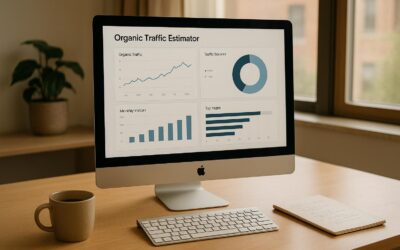Demographic and psychographic SEO helps you better understand your audience by combining measurable traits (like age, gender, and income) with deeper insights into their motivations, values, and behaviors. Here’s why it matters:
- Demographics tell you who your audience is: age, location, education, income, etc.
- Psychographics reveal why they act: interests, values, shopping habits, and preferences.
- Together, they help you create content that connects with your audience on both a practical and emotional level.
This approach improves keyword targeting, content relevance, and user engagement by addressing both the needs and mindsets of your audience. For example, knowing your audience’s values (like prioritizing sustainability) can shape not just keywords but also tone and content style.
Key Takeaways:
- Demographics provide a broad understanding of your audience.
- Psychographics add depth by uncovering motivations and preferences.
- Combining both improves SEO results: higher engagement, better CTRs, and more conversions.
Keep reading to learn how to gather this data, apply it to your SEO strategy, and track results effectively.
What is target audience research? | Free Digital Marketing Course
Demographics vs Psychographics: Main Differences
Both demographics and psychographics play a role in understanding your audience, but they rely on different types of data. Demographics focus on observable characteristics, while psychographics delve into the motivations and behaviors that drive decisions.
Recognizing these differences helps you decide when to use each type of data and how to blend them for a more effective SEO strategy.
Data Types and Focus Areas
Demographic data is all about numbers. It includes measurable factors like age, gender, income, education, geographic location, occupation, and family status. These characteristics tend to remain relatively stable over time and are easy to verify through surveys, census data, or analytics platforms.
Psychographic data digs deeper into the "why." It explores values, beliefs, interests, hobbies, personality traits, and motivations. Unlike demographics, psychographics are more fluid, often influenced by personal experiences, societal trends, or life changes. Collecting this data requires more nuanced techniques like interviews, behavioral studies, or monitoring social media activity.
From an SEO perspective, demographics help identify general trends like device preferences or the best times to post content. Psychographics, on the other hand, reveal search intent and language patterns. For instance, someone who prioritizes sustainability might search for terms like "eco-friendly", "sustainable", or "environmentally responsible", regardless of their age or income bracket.
By understanding these differences, you can craft content and SEO strategies that address both measurable trends and the deeper motivations of your audience.
Comparison Table: Demographics vs Psychographics
| Aspect | Demographics | Psychographics |
|---|---|---|
| Data Type | Quantitative, factual | Qualitative, interpretive |
| Examples | Age: 35, Income: $65,000, Location: Denver | Values sustainability, enjoys outdoor activities, prefers premium brands |
| Collection Method | Surveys, analytics, public records | Interviews, social listening, behavioral tracking |
| Stability | Changes slowly over time | Can shift with trends and experiences |
| SEO Application | Device targeting, local SEO, timing | Keyword selection, content tone, user experience |
| Targeting Precision | Broad audience segments | Narrow, specific niches |
| Content Creation | Focus on format and accessibility | Focus on messaging and emotional appeal |
This comparison highlights when to rely on quantitative demographics and when qualitative psychographics take center stage.
When to Focus on Psychographic Data
Psychographics become essential when numeric data alone can’t explain user behavior.
Psychographic segmentation shines in competitive markets where multiple brands cater to similar demographic groups. For example, if you’re selling premium outdoor gear, knowing your audience includes 30-45-year-old professionals earning $75,000+ annually is helpful. But understanding that they value environmental responsibility, prefer quality over price, and seek authentic brand experiences can completely reshape your content strategy.
Content personalization thrives on psychographics. Even when two users share identical demographics, their psychographics may lead to vastly different content preferences. Tailoring your messaging to these deeper insights results in stronger connections with your audience.
Psychographics also help differentiate your brand. In crowded markets where competitors target the same demographic, psychographic insights allow you to stand out by creating content that resonates on a personal level, boosting engagement and loyalty.
For complex purchase decisions – like choosing a software subscription, planning a home renovation, or selecting financial services – psychographics provide clarity. Understanding the emotional and psychological factors behind these decisions often outweighs basic demographic data.
In short, demographics set the stage, but psychographics write the story. By combining both, you can create more precise audience personas and run SEO campaigns that truly connect with your target audience.
How to Collect and Analyze Audience Data
Understanding your audience is the backbone of any effective SEO strategy. By gathering accurate demographic and psychographic data, you can create campaigns that resonate with your target audience on a deeper level. Here’s how to collect and analyze this vital information.
Methods for Gathering Demographic Data
Google Analytics is a go-to tool for demographic insights like age, gender, location, and device preferences. You’ll find this data in the Audience Demographics section, where it’s automatically tracked. No extra setup is required, making it a straightforward starting point.
Customer databases from sign-ups or purchases are another goldmine. Platforms like Mailchimp and Constant Contact allow you to segment your audience based on factors such as location, purchase history, and engagement trends.
Social media analytics provide detailed follower demographics. Whether you’re using Facebook, LinkedIn, Instagram, or TikTok, their business tools offer insights into age, gender, and professional backgrounds.
Public datasets can fill in any gaps. For example, the U.S. Census Bureau offers detailed demographic information by ZIP code, city, and state, while Google Trends highlights regional search behaviors.
Survey tools like SurveyMonkey or Typeform let you ask your audience directly. Keep surveys short – 5 to 7 questions is ideal – and consider offering small incentives, like discounts, to encourage participation.
Once you’ve gathered demographic data, it’s time to dive into the psychological factors that drive user behavior.
Sources for Psychographic Data
Direct surveys can uncover motivations and values. Instead of leading questions like “Do you care about the environment?” ask open-ended ones such as “What influences your purchasing decisions the most?” This approach yields more authentic insights.
Social media listening tools like Hootsuite Insights or Sprout Social help you monitor brand mentions, hashtags, and comments. Pay attention to the tone and language people use when discussing your products or services, as these can reveal psychographic traits.
Customer interviews are invaluable for gaining clarity. Set up 15–20 minute calls with recent customers to learn about their goals, challenges, and decision-making processes. Record these interviews (with consent) and look for recurring themes.
Website behavior analysis tools like Hotjar or Crazy Egg offer a window into how users interact with your site. Heatmaps show which areas get the most attention, while session recordings reveal navigation patterns. For instance, users who linger on product specs likely value detailed research, while those focused on testimonials may seek social proof.
Email engagement patterns can also provide psychographic clues. For example, subscribers who frequently open emails about industry trends may prioritize staying informed, while those engaging mostly with discounts might be more price-sensitive.
Review and feedback analysis is another effective method. Dive into customer reviews on platforms like Google, Yelp, or your own website. Look for recurring themes – whether it’s a focus on quality, convenience, or another aspect of your offerings.
With these data sources in hand, it’s important to follow ethical guidelines and best practices to ensure both accuracy and trust.
Best Practices and Privacy Guidelines
Be transparent about data collection. Clearly explain why you’re collecting data and how it will be used. Adding privacy statements to surveys and forms helps build trust and encourages honest responses.
Adhere to GDPR and CCPA principles. Even if your business isn’t legally required to comply, following these regulations is a smart move. Always get explicit consent, provide opt-out options, and offer the ability to request data deletion. Securely store data and limit access to only those who need it.
Use both quantitative and qualitative methods. For example, if analytics show high bounce rates among mobile users in a specific age group, supplement that data with targeted surveys or interviews to uncover the reasons.
Conduct regular data audits. Review your collection methods every quarter to ensure your data remains accurate and relevant. Psychographic data, in particular, can shift with changing trends or major events.
Segment your analysis by source. Social media followers might have different traits compared to email subscribers or website visitors. Analyze each group separately to avoid skewing your overall understanding.
Test your findings with experiments. If your psychographic analysis suggests your audience values sustainability, try creating eco-focused content and measure the response. A/B testing can help refine your messaging even further.
Document your processes. Having templates for surveys, interview questions, and analysis methods ensures consistency over time. This is especially useful as your team grows, helping maintain data quality and streamlining onboarding for new members.
Using Audience Data in Your SEO Strategy
Now that you’ve gathered audience data, it’s time to translate those insights into actionable SEO strategies. The goal? Align your approach with how users search and interact online.
Building Data-Based User Personas
Start by creating user personas rooted in data. These personas should go beyond basic demographics like age and location. Dive deeper into their motivations, challenges, and search habits.
For instance, if your data shows that professionals aged 35-45 in urban areas often engage with detailed product comparisons and spend time researching before buying, you might craft a persona like the "Research-Driven Professional." This persona would represent users who favor longer, detailed search queries and value comprehensive information over quick answers.
Connect search behaviors with motivations. For example, someone focused on convenience might search for "best [product] near me", while a value-driven user might lean toward terms like "affordable" or "compare prices." Your personas should reflect these preferences, capturing the language and intent behind searches.
Incorporate device and timing data. Analytics can reveal how and when users browse. Mobile users, for instance, may prefer quick, scannable content, while desktop users might engage with longer, in-depth pieces during extended research sessions.
Finally, validate your personas with real search data. Tools like Google Search Console can show the queries driving traffic to your site. If your "Budget-Conscious Millennial" persona assumes price-focused searches, but your data shows brand-specific queries, adjust your strategy accordingly.
Creating Content for Specific Personas
Tailor content themes to match motivations. If a segment values exclusivity and status, your content should emphasize premium qualities with terms like "elite", "professional-grade", or "industry-leading." On the other hand, for a practical audience, focus on benefits like efficiency, time-saving, or problem-solving.
Match content depth to research habits. Users who dig deep during research need thorough content like detailed guides, comparison articles, and FAQs. Those who prefer quick decisions will appreciate concise product pages, bullet-point highlights, and clear calls-to-action.
Adapt content formats to preferences. If a demographic engages heavily with video on social media, integrate video tutorials or product demos into your strategy. Optimize these for SEO to ensure they reach the right audience.
Speak their language. Different personas use different terms for the same concept. For example, a technical audience might search for "API integration", while business users might look for "software connection." Create content that uses the specific terminology of each group.
Structure content for decision-making styles. If a persona needs social proof, include testimonials, case studies, and user reviews prominently. Analytical users, on the other hand, might respond better to detailed specifications, comparison charts, and data-backed evidence. This targeted approach ensures your content ranks for relevant searches while meeting user needs.
Technical SEO Improvements Using Audience Data
Once your content is tailored to your personas, refine your technical SEO to enhance their experience.
Leverage schema markup for intent alignment. If local searches are common, use LocalBusiness schema to highlight your geographic relevance. For e-commerce targeting price-sensitive users, Product schema with pricing details can help your products stand out with rich snippets.
Optimize page speed for mobile users. If your analytics show high mobile usage, prioritize mobile performance. Compress images, streamline JavaScript, and ensure responsive design. Google’s Core Web Vitals play a key role in search rankings, especially with mobile-first indexing.
Align headings with search queries. Analyze the questions and phrases your personas use, then incorporate them naturally into your H2 and H3 headings. For example, if users often search "how to choose [product type]", make it a heading in your content. This approach improves both search engine understanding and user experience.
Use internal linking to guide user journeys. Design links that cater to how personas navigate your site. For example, connect beginner content to advanced guides for users seeking more depth, or link product pages to comparison articles for research-focused personas.
Write persona-specific meta descriptions. Instead of generic descriptions, address each persona’s motivations directly. Highlight cost savings for value-conscious users or premium features for status-focused segments. This can boost click-through rates from search results.
Add structured data for FAQs. If your audience frequently asks specific questions, use FAQ schema to make your content eligible for featured snippets and voice search results. This is especially effective for users who prefer quick, straightforward answers.
Tracking Results and Improving Your Strategy
Once you’ve implemented your targeting efforts, the next step is to measure their impact. The right metrics can help you understand what’s working, what isn’t, and where you might need to make adjustments. These insights also validate the refined personas and content strategies you’ve worked so hard to develop.
Key Metrics for SEO Performance
Engagement rates are a great starting point for gauging how well your content resonates with specific audience segments. Metrics like time on page, bounce rate, and social interactions can reveal a lot. For instance, if one segment spends significantly more time on detailed content compared to brief articles, it’s a good sign that your targeting is hitting the mark.
Similarly, keep an eye on click-through rates (CTR) from search results. If your meta descriptions speak directly to a persona’s motivations – like using phrases such as "affordable solutions" for budget-conscious users – you should see a noticeable improvement in CTRs from those groups compared to generic descriptions.
Conversion rates and organic traffic are key indicators of whether your demographic and psychographic strategies are driving real results. Track how many users from each persona complete desired actions, such as signing up for a newsletter, downloading a resource, or making a purchase. Tools like Google Analytics can also help you filter traffic growth by specific audience segments.
Website behavior analytics offer deeper insights into what your audience prefers. Look at which pages different segments visit, how they navigate your site, and which products or content grab their attention. This data can help you fine-tune your understanding of each persona’s behavior.
"Social media analytics let you identify trends in interests and attitudes, and even use sentiment analysis to help dig a little more deeply into psychographic attitudes." – Alexandra Samuel, Harvard Business Review
Use these metrics to guide ongoing tests and refine your messaging and design over time.
Testing and Adjusting Campaigns
A/B testing is a powerful tool, especially when you segment results by audience characteristics. Try experimenting with different images, headlines, or content layouts tailored to specific persona groups. This can help you identify which experiences resonate most with each audience.
For example, test content messaging by comparing a cost-focused version against one that emphasizes premium features. Then, analyze performance across different demographic segments to see which approach works best for each group.
You can also test content depth and format based on your audience’s browsing habits. If analytics reveal that some users prefer quick, scannable content while others engage more with in-depth guides, adjust your content accordingly. Metrics like time on page, scroll depth, and conversion rates can help you determine what formats perform best.
Monitor content engagement by topic to uncover psychographic trends. If sustainability-focused articles suddenly gain traction with a particular demographic, it might indicate growing interest in environmental issues within that group. Use these insights to tweak your content calendar and keyword strategy.
Finally, keep your data collection up-to-date. Audience preferences evolve over time, so it’s essential to regularly review analytics from tools like Google Analytics, social media platforms, and CRM systems. Setting aside time for monthly or quarterly reviews can help you spot new trends and adjust your targeting as needed.
Tools and Resources for Better Results
With insights from your tests, you can use specialized tools to track and enhance your performance.
- Google Analytics 4 offers detailed reports on audience behavior and engagement. Use its demographic and interest data to see how different segments interact with your content, and take advantage of its enhanced tracking features to measure key events.
- Google Search Console is invaluable for analyzing search queries that drive traffic from different audience segments. These insights can help refine your keyword strategy and improve your content.
- Social media analytics tools, like Facebook Insights, Twitter Analytics, and LinkedIn Analytics, provide real-time data on follower behavior and content performance. They also break down demographics, showing which types of content generate the most engagement.
- CRM tracking systems let you monitor interactions across multiple touchpoints, from website visits to email clicks and social media engagement. This gives you a complete view of each persona’s customer journey.
- SearchX provides SEO analysis tools to measure how well your demographic and psychographic targeting efforts are paying off. Its keyword research and content optimization features help identify opportunities to better serve specific audience segments, while technical SEO audits ensure your site performs well for all users.
- A/B testing platforms, such as Google Optimize or Optimizely, allow you to test different content versions with specific audience segments. These tools enable you to systematically improve your targeting based on real user behavior.
To make tracking easier, set up automated dashboards segmented by audience. This way, you can quickly identify trends and refine your strategy as needed.
Conclusion: Using Demographic and Psychographic SEO for Better Results
Demographic and psychographic insights take SEO from a basic keyword game to a strategy powered by real data. Demographics tell you the ‘what’ – things like age, location, and income – while psychographics dig into the ‘why’ behind user choices. For instance, a 35-year-old marketing manager in Chicago might search for "project management software." But knowing whether they’re driven by a need for efficiency, cost savings, or better team collaboration lets you create content that speaks directly to their priorities.
Building data-driven user personas is the backbone of this approach. Everything – keywords, content layout, technical tweaks, and even meta descriptions – can be tailored to fit specific audience groups. This level of precision often leads to better click-through rates, more time spent on your site, and higher conversions compared to one-size-fits-all SEO strategies.
Success hinges on constant monitoring and adjustments. Audience preferences and behaviors shift, so keeping tabs on metrics like engagement, conversions, and user patterns is crucial. Monthly analytics reviews can uncover new trends and areas for improvement, ensuring your strategy stays relevant.
At the same time, respecting privacy and using ethical data collection practices are non-negotiable. Transparency builds trust, which is essential for long-term SEO success.
This targeted approach gives you an edge that’s hard for competitors to copy. While others chase broad keyword rankings, you’re delivering exactly what your audience wants, precisely when they need it. This kind of personalized, relevant content doesn’t just draw visitors – it turns them into loyal customers. And the benefits don’t stop at SEO. These insights can supercharge your entire digital marketing game, from social media to email campaigns to overall user experience.
FAQs
How can I use demographic and psychographic data to enhance my SEO strategy?
To take your SEO strategy to the next level, try blending demographic data – like age, location, and income – with psychographic insights such as values, interests, and lifestyle choices. This combination gives you a deeper understanding of your audience, allowing you to create content and choose keywords that genuinely connect with specific groups.
When you align your SEO efforts with these audience profiles, you’re not just improving engagement – you’re also increasing conversion rates and delivering a more tailored user experience. Tools like AI and analytics can help fine-tune this approach, making your strategy sharper and more effective.
How can I collect psychographic data to better understand my audience?
To collect psychographic data, you can tap into several methods that reveal your audience’s values, interests, and behaviors. Start with surveys, which let you ask specific questions about their lifestyles and preferences. For a more in-depth look, conduct customer interviews to explore their motivations and beliefs on a personal level. Another effective approach is analyzing social media activity – engagement patterns and posts often highlight trends in attitudes and personality traits. Reviewing existing customer profiles and online interactions can also help you spot recurring themes and preferences. By combining these strategies, you’ll gain a clearer, more detailed picture of your audience’s psychographic makeup.
How can I make sure my data collection follows privacy laws like GDPR and CCPA?
To make sure your data collection aligns with privacy laws like GDPR and CCPA, prioritize clarity and user consent. Only gather the information that’s absolutely necessary, and make it clear to users how their data will be used. Also, offer simple options for users to opt out or adjust their preferences.
Regularly update your privacy policies to reflect the latest regulations and review them frequently. These steps not only help you stay compliant but also build trust with your audience and uphold ethical data practices within your SEO strategies.




